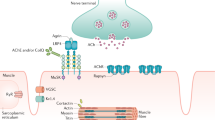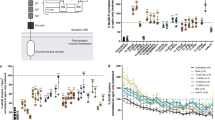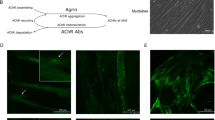Abstract
MYASTHENIA gravis is a neuromuscular disorder characterised by muscle weakness and fatigability. Muscle fibres from myasthenic patients have reduced amplitudes of endplate potentials and miniature endplate potentials1,2. Early studies concluded that the disorder was presynaptic in origin because the postsynaptic chemosensitivity of the myasthenic muscle fibres was found to be normal1, but recent evidence indicates that myasthenia gravis is an autoimmune disease directed against the postsynaptic acetylcholine receptors3,4. Myasthenic serum globulin has been shown to bind to the acetylcholine receptors5,6, myasthenic muscle contains only 11–30% of α-bungarotoxin binding sites compared with normal muscle7, and iontophoretic studies showed that the acetylcholine sensitivity of the postsynaptic region of myasthenic muscle was markedly reduced2. But the failure of in vitro application of myasthenic serum to reduce the junctional or extrajunctional sensitivity of human, rat or frog muscle8 has raised doubt on the involvement of the serum factor in the disease. In this report we show that the acetylcholine sensitivity of cultured rat myotubes is greatly reduced by in vitro application of myasthenic serum.
This is a preview of subscription content, access via your institution
Access options
Subscribe to this journal
Receive 51 print issues and online access
$199.00 per year
only $3.90 per issue
Buy this article
- Purchase on Springer Link
- Instant access to full article PDF
Prices may be subject to local taxes which are calculated during checkout
Similar content being viewed by others
References
Elmquist, D., Hofmann, W. W., Kugelbery, J. & Quastel, D. M. J. J. Physiol., Lond. 174, 417–434 (1964).
Albuquerque, E. X., Rash, J. E., Mayer, R. F. & Scatterfield, J. R. Expl Neurol. 51, 536–563 (1976).
Elias, S. B. & Appel, S. H. Life Sci. 18, 1031–1038 (1976).
Grob, D. Ann. N.Y. Acad. Sci. 274, 1–2 (1976).
Almon, R., Andrew, C. G. & Appel, S. H. Science 186, 55–57 (1974).
Almon, R. & Appel, S. H. Biochim. biophys. Acta 34, 66–77 (1975).
Fambrough, D. M., Drachman, D. B. & Sutyomurti, S. Science 182, 243–295 (1973).
Albuquerque, E. X. et al. Ann. N.Y. Acad. Sci. 274, 475–492 (1976).
Yaffe, D. Proc. natn. Acad. Sci. U.S.A. 61, 477–483 (1968).
Fambrough, D. M. & Rash, J. Devl Biol. 26, 55–68 (1971).
Appel, S. H., Anwyl, R., McAdams, M. W. & Elias, S. B. Proc. natn. Acad. Sci. U.S.A. (in the press).
Author information
Authors and Affiliations
Rights and permissions
About this article
Cite this article
ANWYL, R., APPEL, S. & NARAHASHI, T. Myasthenia gravis serum reduces acetylcholine sensitivity in cultured rat myotubes. Nature 267, 262–263 (1977). https://doi.org/10.1038/267262a0
Received:
Accepted:
Issue Date:
DOI: https://doi.org/10.1038/267262a0
This article is cited by
Comments
By submitting a comment you agree to abide by our Terms and Community Guidelines. If you find something abusive or that does not comply with our terms or guidelines please flag it as inappropriate.



